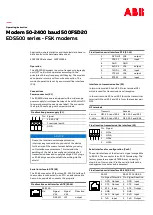
18
Modem 34336
For V.25 bis operation, the Modem must be configured to use the same data
protocol as the attached DTE. V.25 bis mode operation and commands are
explained in detail in
Chapter 6.0, V.25 bis Audodialer
.
Asynchronous V.25 bis Operation.
The data format of the DTE should be set to 7 data bits with even parity and
one stop bit. The default DTE interface rate is 38,400 bps in asynchronous
mode.
V.25 bis commands can be entered from the DTE keyboard. Example:
CRN 5551234
In response to this command, the Modem sends a VAL result code back
to the DTE (indicating that the command is accepted), dials the telephone
number 555-1234, and then waits for an answer tone from the remote
modem. If no carrier is detected within a given time (default is 45 seconds),
the modem automatically releases the line and sends a
CFI NT
result code
to the attached DTE.
Spaces entered in the command line for clarity are ignored:
CRN 555 1212
has the same effect as
CRN5551212
.
When a phone number is successfully dialed, the EIA status screen
on the Modem looks like the one shown below.
Synchronous V.25 bis Operation
The data format of the DTE should be set to 7 data bits with odd parity.
In synchronous applications, the V.25 bis commands can be used to facilitate
computer-controlled operations.
Synchronous bit-oriented operation uses High-Level Data Link Control
(HDLC) formatting.
Synchronous character-oriented operation uses synchronous start-of-text
and end-of-text characters to frame messages. The start-of-text character
is preceded by two synchronous (SY) characters.
D TR MR RS CS
9600 CD
1
2
3
















































